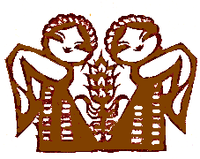- Chinese paper cutting
-
Chinese Paper Cutting or Jianzhi (剪纸) is the first type of papercutting design, since paper was invented by Cai Lun in the Eastern Han Dynasty in China. The art form later spread to other parts of the world with different regions adopting their own cultural styles. Because the cut outs are also used to decorate doors and windows, they are sometimes referred to "chuāng huā" (窗花), meaning Window Flower.
Contents
History
Most of the people with access to paper for an entertainment cause such as art were usually nobles in royal palaces.[1] The Song Dynasty scholar Chou Mi mentioned several paper cutters who cut paper with scissors into a great variety of designs and characters in different styles, and a young man who could even cut characters and flowers inside his sleeve.[2] The oldest surviving paper cut out is a symmetrical circle from the 6th century found in Xinjiang, China.[2]
From the 7th to 13th century, paper cutting became popular especially during Chinese holiday festivals. The art spread to the rest of the world in the 14th century. Throughout the Qing Dynasty many papercutting skills were developed including drafting and the use of smoked papers. By the end of the Qing ruling however, new art forms were being introduced. The Republic of China later tried to revive the art in the 1980s.[1]
In the rural countryside in mainland China, papercutting is a traditionally female activity. In the past, every girl was expected to master it and brides were often judged by their skill. Professional papercutting artists are, on the other hand, usually male and have guaranteed incomes and work together in workshops.
Symmetry
There are basic cut outs, that are a single image. And there are symmetrical designs that are usually created by some folding over a proportioned crease, and then cutting some shape. When unfolded, it forms a symmetrical design. The paper cut outs are usually in an even number series of 2, 4, 24 etc.
Uses
Today, papercuttings are chiefly decorative. They ornament walls, windows, doors, columns, mirrors, lamps and lanterns in homes and are also used on presents or are given as gifts themselves. Entrances are decorated with paper cut outs is supposed to bring good luck. Papercuttings used to be used as patterns, especially for embroidery and lacquer work.
In Chinese culture it can reflect many aspects of life such as prosperity, health, or harvest. Some cuttings represent stories about the happiness gained from the accomplishment of common goals.
Process
There are two methods of manufacture: one use scissors, the other use knives. In the scissor method, several pieces of paper — up to eight — are fastened together. The motif is then cut with sharp, pointed scissors.
Knife cuttings are fashioned by putting several layers of paper on a relatively soft foundation consisting of a mixture of tallow and ashes. Following a pattern, the artist cuts the motif into the paper with a sharp knife which is usually held vertically. Skilled crafters can even cut out different drawings freely without stopping.
See also
References
- ^ a b Needham, Joseph. Chemistry and Chemical Technology. [1974] (1974). Cambridge University Press. ISBN 0521086906
External links
Categories:- Chinese art
- Paper art
- Arts in China
- Folk art
Wikimedia Foundation. 2010.


